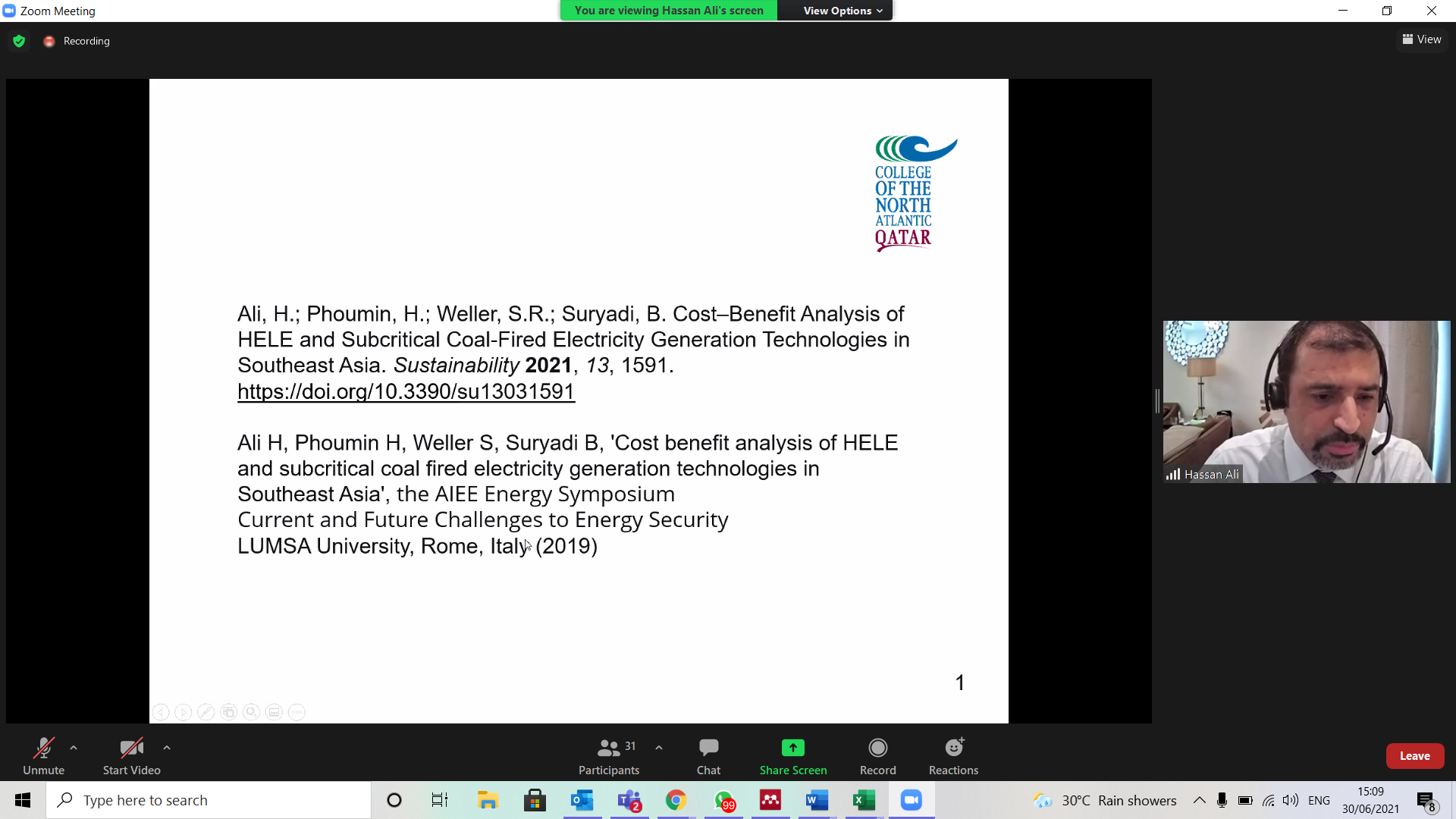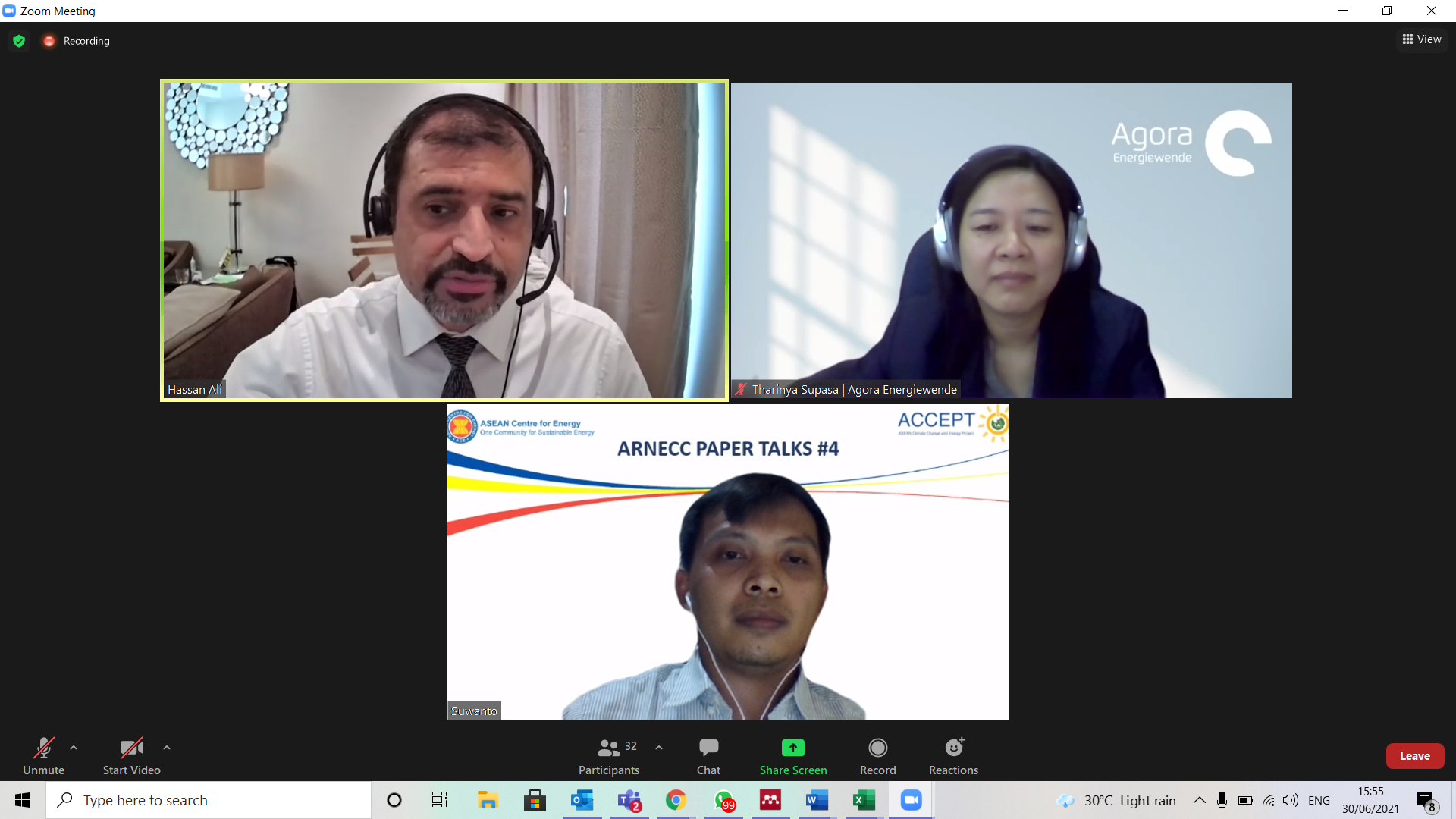
Jakarta, 30 Jun 2021
The ASEAN Climate Change and Energy Project (ACCEPT) presented the ASEAN Researchers Network on Energy and Climate Change (ARNECC) Paper Talks, a monthly discussion platform for the latest published papers and articles on the energy and climate change nexus in Southeast Asia.
After successfully held three similar events, ACCEPT organized the fourth session which was held on 30th June 2021 attended by diverse group of scholars. It features Dr Hassan Ali from School of Engineering Technology and Industrial Trades, College of the North Atlantic – Qatar. He discussed the recent published paper entitled “Cost-Benefit Analysis of HELE and Subcritical Coal-Fired Electricity Generation Technologies in Southeast Asia” which also co-author by Beni Suryadi, Manager of PFS at ACE. It was published at Sustainability, February 2021, Vol. 13, Special Issue Secure and Sustainable Energy System in the MDPI. Dr Tharinya Supasa, Project Lead Energy Policy Southeast Asia at Agora Energiewende is also invited as a commentator to enrich the talks and broaden the participants knowledge on the issue. Additionally, the session moderated by Suwanto, a Technical Officer at ACE.

Dr. Hassan Ali started the presentation by showing us the background of this study which are coal fired electricity generation with a total capacity of 1700 GW account for 41% of electricity generation worldwide, responsible for over 28% of global CO2 emissions, responsible for global warming and associated with devastating public health and environmental impacts. In addition, several coal user countries have also been working on their national plans to kick in global efforts to reduce CO2 emissions from their electricity generation sectors through development and deployment of high-efficiency, low-emission (HELE) coal-fired power generation technologies.
This paper also discussed about the actions for reducing CO2. First, to increase generation from plants deploying HELE technology. Second, to decrease generation from subcritical plants. Third, to install Carbon Capture and Sequestration (CCS) on plants deploying HELE technology. HELE technology pathway is necessary for ASEAN Member States (AMS) because coal is the largest source of electricity generation in this region and according to IEA, installed capacity to increase around 160 GW by 2040. Coal generation will also overtake gas by 2040 and provide 40% of electricity generation by 2040. There is a regional understanding among AMS that growing use of coal will necessitate a HELE technology energy pathway. Meanwhile, the challenges for HELE technologies are: HELE coal-fired technologies are expensive to build, high cost is the main restriction element for large scale deployment. Therefore subcritical technology has been traditionally preferred due to their low upfront costs and shorter lead time. it is highly likely that project developers end up accepting lower efficiency and poor emission rates from sub-critical coal-fired technology. To decarbonize electricity sector by 2050 under 2DS, subcritical plants need to be completely phased out by 2050However, progress on current deployment of HELE coal fueled facilities is slow, hence subcritical units are still being deployed.
To assess the cost of electricity generation, this study used Levelized Cost of Electricity (LCOE) generation that represents the lifetime average costs of electricity as a constant unit price (in USD per megawatt-hour (USD/MWh) for a specific electricity generation project. The LCOE is calculated by dividing the project’s overall expected lifetime costs (including construction, fuel, financing, maintenance, insurance, taxes and incentives) with the project’s lifetime expected power output (MWh). The LCOE is used to assess four generated scenarios in this study to reduce the emission, namely Scenario 1 as base scenario, Scenario 2 as climate change mitigation scenario by adding carbon price, Scenario 3 as pollution control scenario by adding pollution control price, and Scenario 4 as climate change mitigation and pollution control scenario by adding carbon and pollution control prices.
Dr. Hassan Ali continued the presentation by showing us the results of this paper:
To conclude the presentation, Dr. Hassan Ali shared several points regarding to the conclusion of this study. First, the pollution control scenario (i.e., implementation of a carbon pricing policy) surpasses the other scenarios in displacing subcritical plants sooner to pave the way for HELE technologies. Second, the climate change mitigation and pollution control scenario (i.e., a mix of carbon price and emission control technologies) is the second-best driver scenario (at the cost of increased LCOE prices as compared to Scenario 2). Third, reduced coal prices and increased life spans benefit both HELE and subcritical coal-fired power plants. Fourth, HELE coal-fired power plants are economically competitive against subcritical plants. Last, A-USC coal-fired power plants are the most economically attractive choice for deployment in Southeast Asia, followed by USC and SC plants.

Dr Tharinya highlighted several comments on the study namely the validation method and how to cope with the data confidentiality. She also emphasized the importance of this study which could serve as good reference for ASEAN policymakers on the higher efficiency coal-fired compared to the existing coal-fired technologies. Prior wrapping up her comments, she also calls for Dr Hassan or interested participants to write a follow up study on the elaboration of the benefits approach of the said topic.
During the question and answers session, the discussion revolves on the controversiality of the HELE and Subcritical Coal-Fired Electricity Generation Technologies amid the renewable booms and trend to phase-out coal plants. Another issue that coal has lower LCOE and higher reserve than oil or gas-fired power plants, hence it makes that coal is still considered as a vital energy source in ASEAN region.
Access the paper at https://www.mdpi.com/2071-1050/13/3/1591
AB TW